Two-Layer Rubber-Based Composite Material and UHMWPE with High Wear Resistance
Abstract
:1. Introduction
2. Materials and Methods
2.1. Loading and Testing System
2.2. Experimental Materials and Parameters
Technology of Combining Two Materials
- Molding of the UHMWPE layer was carried out for 5 min in the mold under a pressure of 10 MPa at room temperature, the thickness of the layer for examination was ~4 mm.
- A rubber mixture with ~6 mm thickness that was required for the study was laid over the molded layer of the UHMWPE.
- The sample mold was placed in the PCMV-100 hydraulic vulcanization press (Impulse, Ivanovo, Russia), heated to +155 °C, for 20 min at 10 MPa pressure.
- Cooling was carried out in a mold under pressure in a hydraulic press at a temperature up to +80 °C.
3. Results and Discussion
3.1. Characteristics of UHMWPE-Based Composites
3.2. Characteristics of the Elastomeric Material
3.3. Characteristics and Structure of the Two-Layer Materials
4. Conclusions
- The introduction of TMTD, DPG, and MBT into the UHMWPE layer leads to an increase in adhesion between UHMWPE and rubber. The greatest increase in adhesion between rubber and UHMWPE occurs with the introduction of TMTD, which is up to two times higher compared to the materials of the compositions elastomer/UHMWPE-DPG and elastomer/UHMWPE-MBT.
- It has been established that the increase in adhesion between UHMWPE and elastomer is due to the chemical nature of functional additives containing reaction centers that provide chemical cross-linking between the components of the two-layer material. In addition, the oxidative processes that occur during the processing of polymers also contribute to the appearance of oxygen-containing groups involved in intermolecular interaction.
- The SEM method shows the formation of a dense connection between polymers at the interface of a two-layer material and a change in the supramolecular structure of UHMWPE during the introduction of DPG, MBT, TMTD to a denser fibrillar structure.
- The study of linear thermal expansion showed that the introduction of MBT, DPG, TMTD into UHMWPE reduces the linear expansion in the temperature range from minus 80 °C to plus 100 °C. Temperature changes in the linear dimensions of UHMWPE and composites with 0.5 wt.% MBT, DPG, TMTD from 2.9% to 5%, the change in rubber based on the IR is 0.7%.
- The developed materials are designed to produce products that have, on the one hand, high strength and antifriction properties (UHMWPE) and on the other hand, damping properties, elasticity, and resistance to fatigue (rubber).
Author Contributions
Funding
Institutional Review Board Statement
Informed Consent Statement
Data Availability Statement
Conflicts of Interest
References
- Dong, C.; Yuan, C.; Wang, L.; Liu, W.; Bai, X.; Yan, X. Tribological Properties of Water-Lubricated Rubber Materials after Modification by MoS2 Nanoparticles. Sci. Rep. 2016, 6, 35023. [Google Scholar] [CrossRef] [PubMed]
- Dong, C.L.; Yuan, C.Q.; Bai, X.Q.; Yan, X.P.; Peng, Z. Tribological Properties of Aged Nitrile Butadiene Rubber under Dry Sliding Conditions. Wear 2015, 322–323, 226–237. [Google Scholar] [CrossRef]
- Jamari, J.; Ammarullah, M.I.; Santoso, G.; Sugiharto, S.; Supriyono, T.; Prakoso, A.T.; Basri, H.; van der Heide, E. Computational Contact Pressure Prediction of CoCrMo, SS 316L and Ti6Al4V Femoral Head against UHMWPE Acetabular Cup under Gait Cycle. J. Funct. Biomater. 2022, 13, 64. [Google Scholar] [CrossRef] [PubMed]
- Sisanth, K.S.; Thomas, M.G.; Abraham, J.; Thomas, S. General Introduction to Rubber Compounding. In Progress in Rubber Nanocomposites; Elsevier: Amsterdam, The Netherlands, 2017; pp. 1–39. ISBN 978-0-08-100409-8. [Google Scholar]
- Yang, J.; Bai, R.; Chen, B.; Suo, Z. Hydrogel Adhesion: A Supramolecular Synergy of Chemistry, Topology, and Mechanics. Adv. Funct. Mater. 2020, 30, 1901693. [Google Scholar] [CrossRef]
- Bayrak, S.; Paulkowski, D.; Stöckelhuber, K.W.; Staar, B.; Mayer, B. A Comprehensive Study about the Role of Crosslink Density on the Tribological Behavior of DLC Coated Rubber. Materials 2020, 13, 5460. [Google Scholar] [CrossRef]
- Al-Mosawi, A.I.; Al-Maamori, M.H.; Abdulsada, S.A. Mechanical Properties of Hybrid Elastomer Blends. J. Thin Films Coat. Sci. Technol. Appl. 2017, 4, 13–17. [Google Scholar] [CrossRef]
- Barman, A.; Rashid, F.; Farook, T.H.; Jamayet, N.B.; Dudley, J.; Yhaya, M.F.B.; Alam, M.K. The Influence of Filler Particles on the Mechanical Properties of Maxillofacial Prosthetic Silicone Elastomers: A Systematic Review and Meta-Analysis. Polymers 2020, 12, 1536. [Google Scholar] [CrossRef]
- Verheyde, B.; Rombouts, M.; Vanhulsel, A.; Havermans, D.; Meneve, J.; Wangenheim, M. Influence of Surface Treatment of Elastomers on Their Frictional Behaviour in Sliding Contact. Wear 2009, 266, 468–475. [Google Scholar] [CrossRef]
- Krawczyk-Kłys, I.; Makowski, P.; Wójcik, J.; Tyczkowski, J. Plasma Surface Modification of Commercial SBS Rubbers for Enhanced Adhesive Bonding. Mater. Sci. 2012, 18, 132–137. [Google Scholar] [CrossRef] [Green Version]
- Meng, L.; He, J.; Pan, C. Research Progress on Hydrogel–Elastomer Adhesion. Materials 2022, 15, 2548. [Google Scholar] [CrossRef]
- Abdrashitov, E.F.; Ponomarev, A.N. Plasma Modification of Elastomers. High Energy Chem. 2003, 37, 279–285. [Google Scholar] [CrossRef]
- Morozov, I.; Mamaev, A.; Bannikov, M.; Beliaev, A.; Osorgina, I. The Fracture of Plasma-Treated Polyurethane Surface under Fatigue Loading. Coatings 2018, 8, 75. [Google Scholar] [CrossRef] [Green Version]
- Surikov, V.I.; Nikolaev, I.V.; Polonyankin, D.A.; Tselykh, E.P.; Rogachev, E.A.; Surikov, V.I. Morphology, Composition and Tribological Properties of Tantalum Coatings Deposited onto a Rubber Substrate. J. Phys. Conf. Ser. 2017, 858, 012034. [Google Scholar] [CrossRef] [Green Version]
- Tikhomirov, L.A.; Tarasenko, V.A.; Kostina, T.Y.; Dorofeeva, L.V. The Effect of Molybdenum Disulphide on the Tribotechnical Characteristics of Polyamide Coatings on Nitrile Rubber Compounds. Int. Polym. Sci. Technol. 2015, 42, 31–34. [Google Scholar] [CrossRef]
- Kong, H.; Ding, H.; Yu, M.; Ding, X.; Qiao, M. Influence of Poly(P-phenyleneterephalamide) Pulp by Surface Modification with Dopamine to Nitrile Butadiene Rubber. Polym. Compos. 2019, 40, E476–E483. [Google Scholar] [CrossRef]
- Kondo, Y.; Miyazaki, K.; Yamaguchi, Y.; Sasaki, T.; Irie, S.; Sakurai, K. Mechanical Properties of Fiber Reinforced Styrene–Butadiene Rubbers Using Surface-Modified UHMWPE Fibers under EB Irradiation. Eur. Polym. J. 2006, 42, 1008–1014. [Google Scholar] [CrossRef]
- Wang, L.; Gao, S.; Wang, J.; Wang, W.; Zhang, L.; Tian, M. Surface Modification of UHMWPE Fibers by Ozone Treatment and UV Grafting for Adhesion Improvement. J. Adhes. 2018, 94, 30–45. [Google Scholar] [CrossRef]
- Danilova, S.N.; Dyakonov, A.A.; Vasilev, A.P.; Okhlopkova, A.A.; Tuisov, A.G.; Kychkin, A.K.; Kychkin, A.A. Effect of Borpolymer on Mechanical and Structural Parameters of Ultra-High Molecular Weight Polyethylene. Nanomaterials 2021, 11, 3398. [Google Scholar] [CrossRef]
- Abdul Samad, M. Recent Advances in UHMWPE/UHMWPE Nanocomposite/UHMWPE Hybrid Nanocomposite Polymer Coatings for Tribological Applications: A Comprehensive Review. Polymers 2021, 13, 608. [Google Scholar] [CrossRef]
- Aliyu, I.K.; Samad, M.A.; Al-Qutub, A. Tribological Characterization of a Bearing Coated with UHMWPE/GNPs Nanocomposite Coating. Surf. Eng. 2021, 37, 60–69. [Google Scholar] [CrossRef]
- Hussain, M.; Naqvi, R.A.; Abbas, N.; Khan, S.M.; Nawaz, S.; Hussain, A.; Zahra, N.; Khalid, M.W. Ultra-High-Molecular-Weight-Polyethylene (UHMWPE) as a Promising Polymer Material for Biomedical Applications: A Concise Review. Polymers 2020, 12, 323. [Google Scholar] [CrossRef] [PubMed] [Green Version]
- Kovarskiĭ, A.L. (Ed.) High-Pressure Chemistry and Physics of Polymers; CRC Press: Boca Raton, FL, USA, 1994; ISBN 978-0-8493-4239-4. [Google Scholar]
- Dyakonov, A.A.; Danilova, S.N.; Vasiliev, A.P.; Okhlopkova, A.A.; Sleptsova, S.A.; Petrova, N.N.; Mukhin, V.V.; Kychkin, A.K. Investigation of the Diphenylguanidine Effect on the Adhesive Interaction of Ultra-High Molecular Weight Polyethylene with an Elastomer Based on Isoprene Rubber. AIP Conf. Proc. 2020, 2315, 050004. [Google Scholar]
- Kurtz, S.M.; Muratoglu, O.K.; Gsell, R.; Greer, K.; Shen, F.W.; Cooper, C.; Buchanan, F.J.; Spiegelberg, S.; Yau, S.S.; Edidin, A.A. Interlaboratory Validation of Oxidation-Index Measurement Methods for UHMWPE after Long-Term Shelf Aging. J. Biomed. Mater. Res. 2002, 63, 15–23. [Google Scholar] [CrossRef]
- Costa, L.; Bracco, P. Mechanisms of Cross-Linking, Oxidative Degradation, and Stabilization of UHMWPE. In UHMWPE Biomaterials Handbook; Elsevier: Amsterdam, The Netherlands, 2016; pp. 467–487. ISBN 978-0-323-35401-1. [Google Scholar]
- Alam, M.N.; Debnath, S.C.; Choi, J. Nitrosamine-Safe Thiuram Disulfide and Benzothiazole Sulfenamide as a Synergistic Pair of Accelerators for the Vulcanization of Rubber. J. Polym. Res. 2021, 28, 317. [Google Scholar] [CrossRef]
- Silva Murakami, L.M.; Diniz, M.F.; Silva, L.M.; Sanches, N.B.; de Cássia Lazzarini Dutra, R. Off-Line TLC-IR (UATR) Characterization of Additives in EPDM Rubber. Polym. Test. 2019, 79, 106042. [Google Scholar] [CrossRef]
- Worathumrong, N.; Grimes, A.J. The Effect of O-Salicylate upon Pentose Phosphate Pathway Activity in Normal and G6PD-Deficient Red Cells. Br. J. Haematol. 1975, 30, 225–231. [Google Scholar] [CrossRef] [PubMed]
- Nandiyanto, A.B.D.; Oktiani, R.; Ragadhita, R. How to Read and Interpret FTIR Spectroscope of Organic Material. Indones. J. Sci. Technol. 2019, 4, 97. [Google Scholar] [CrossRef]
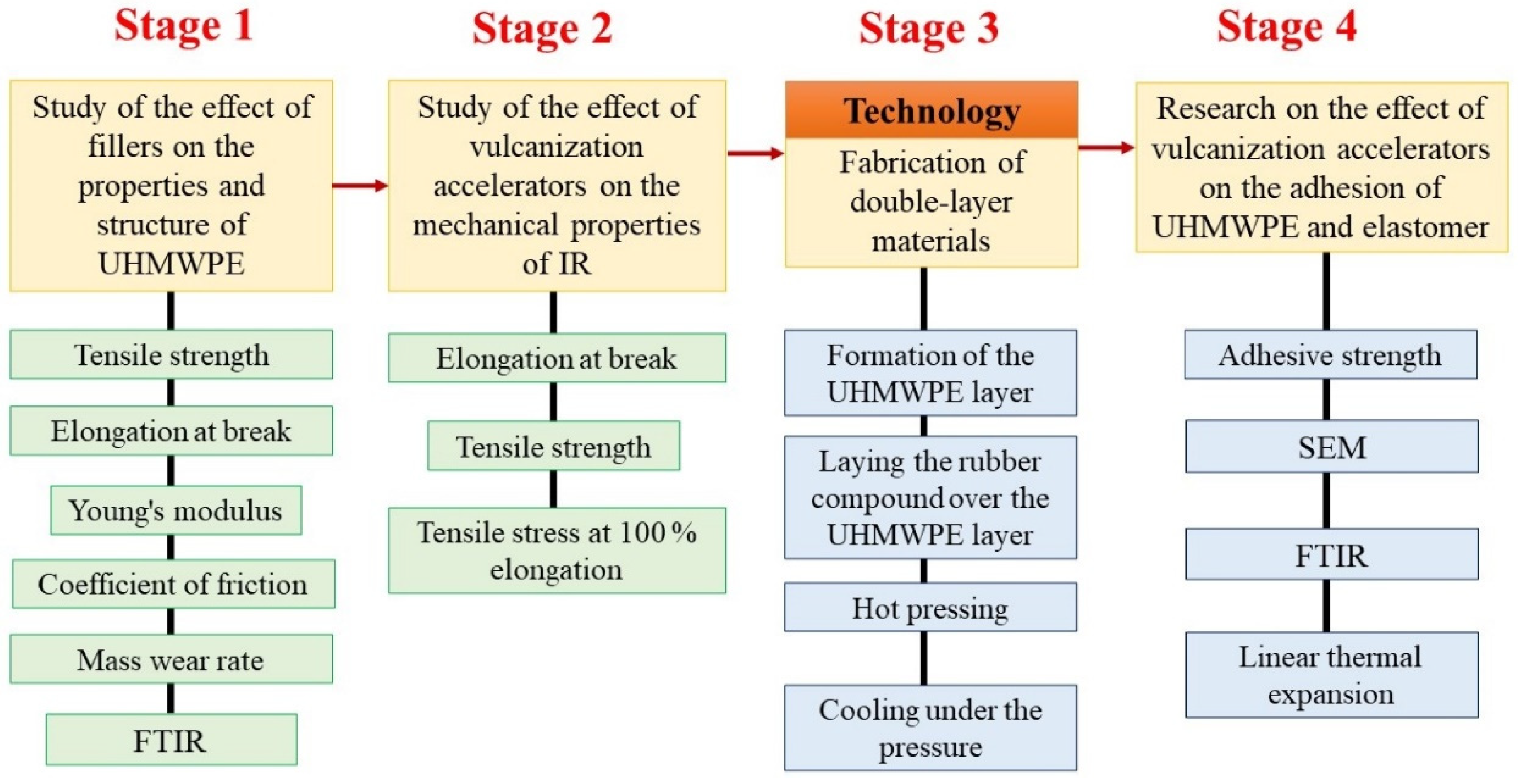

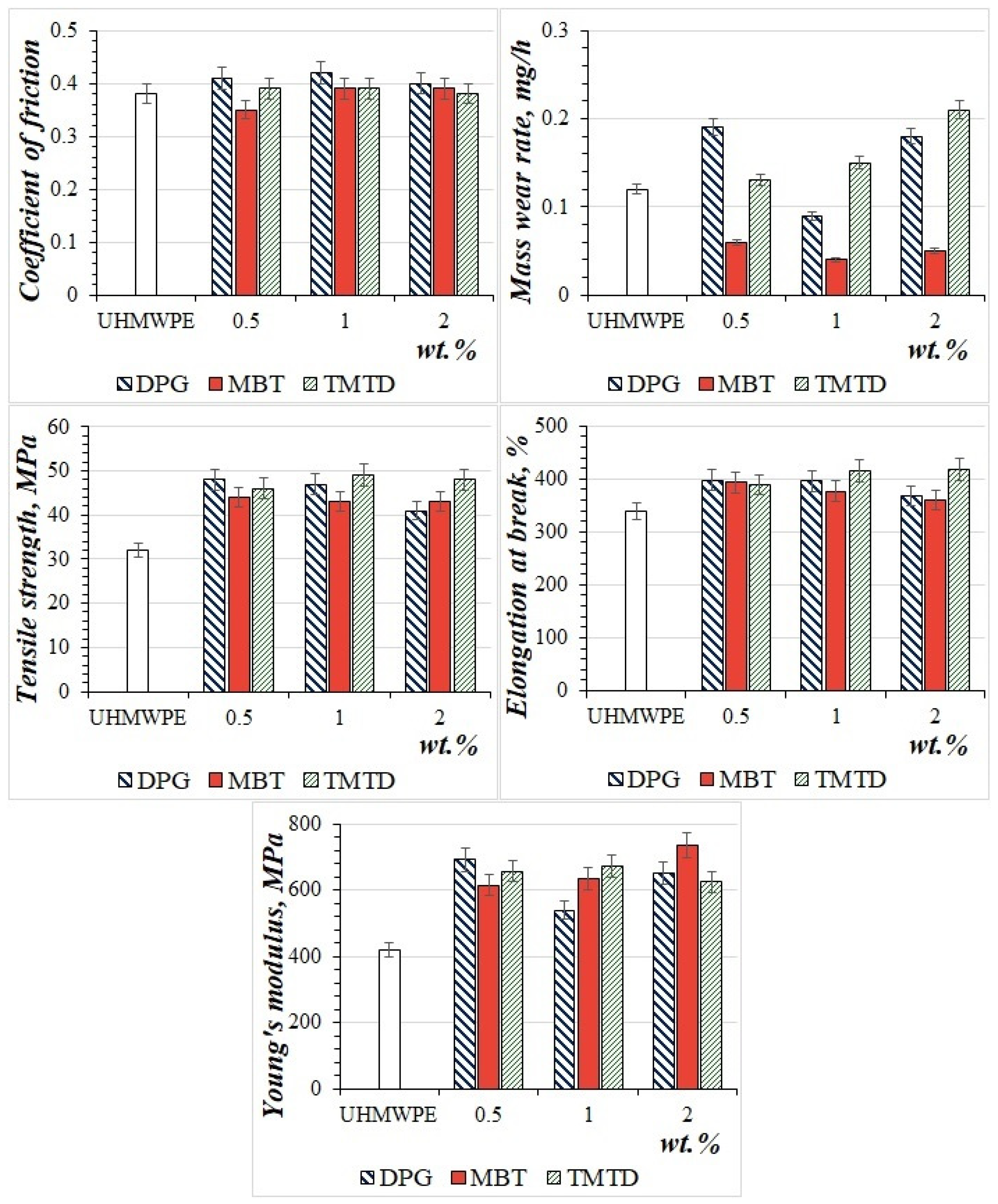
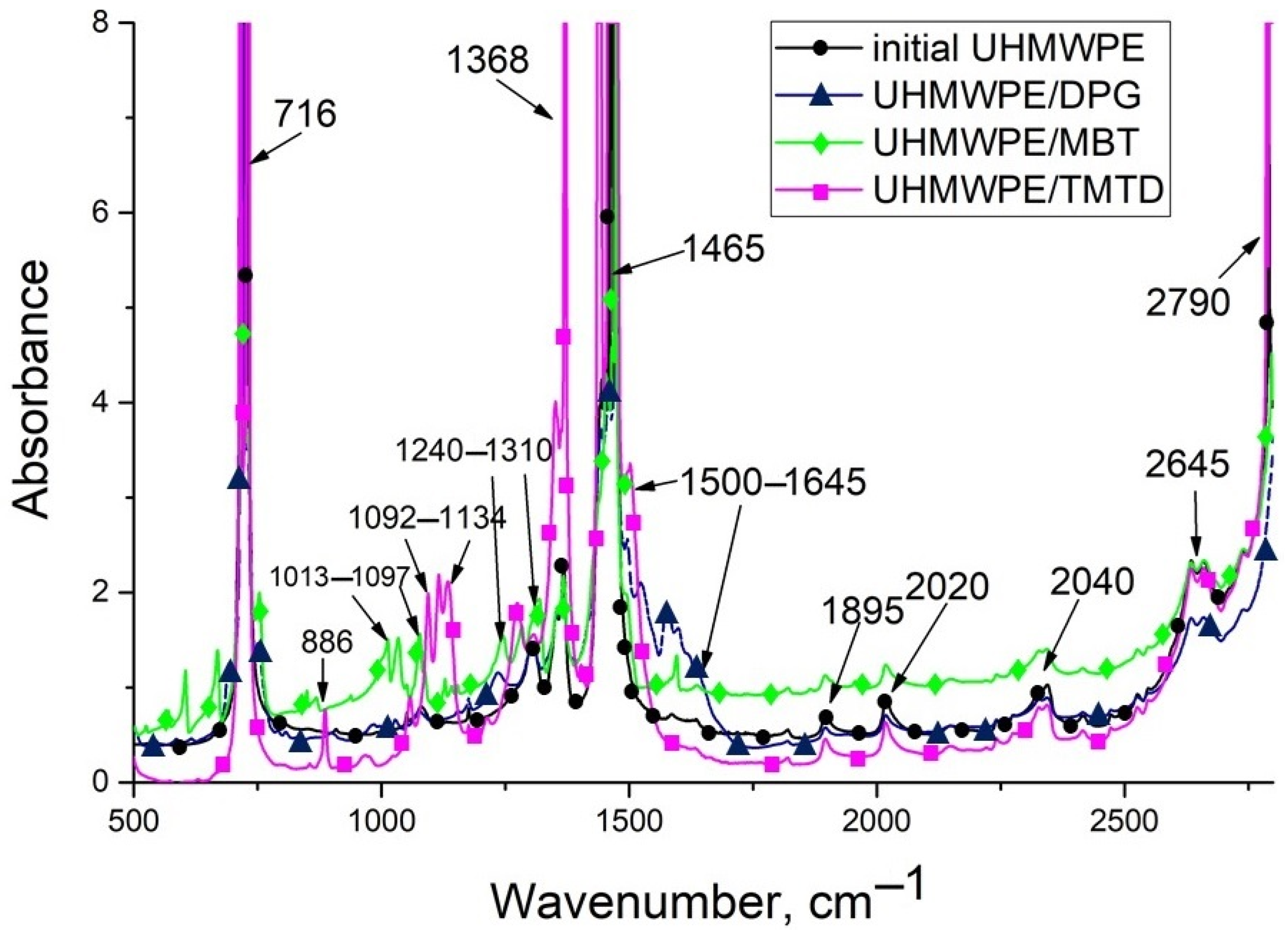
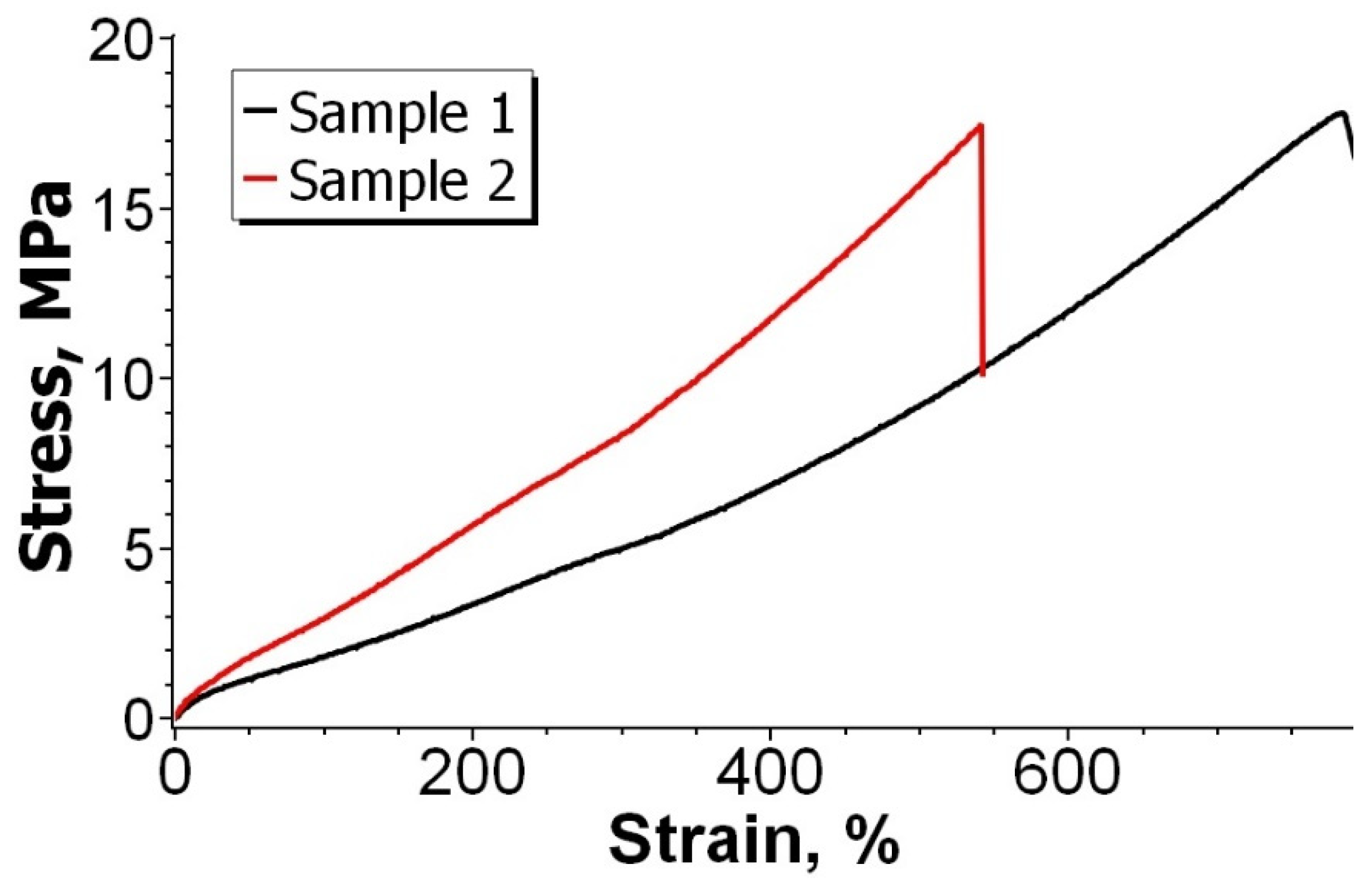

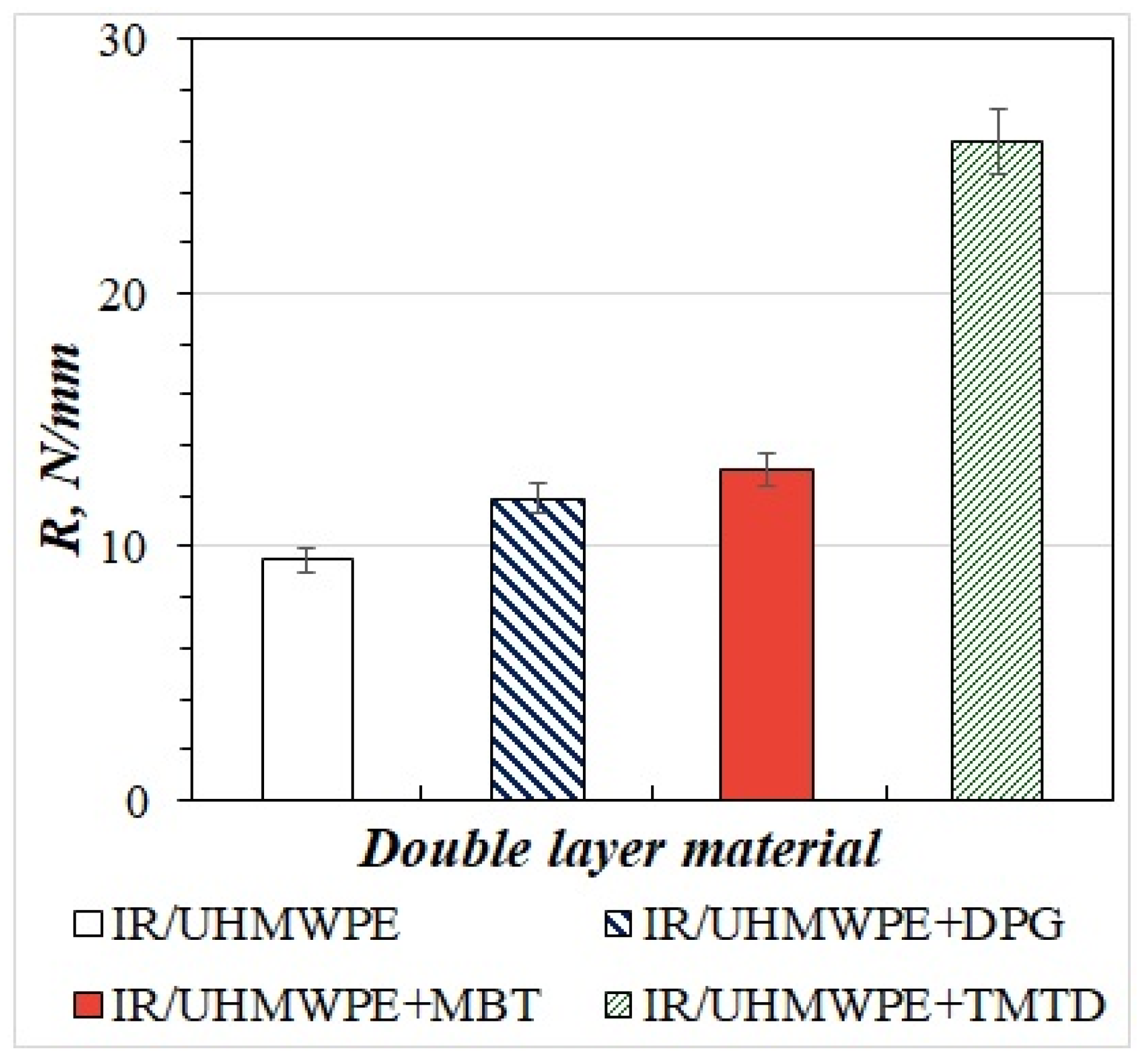

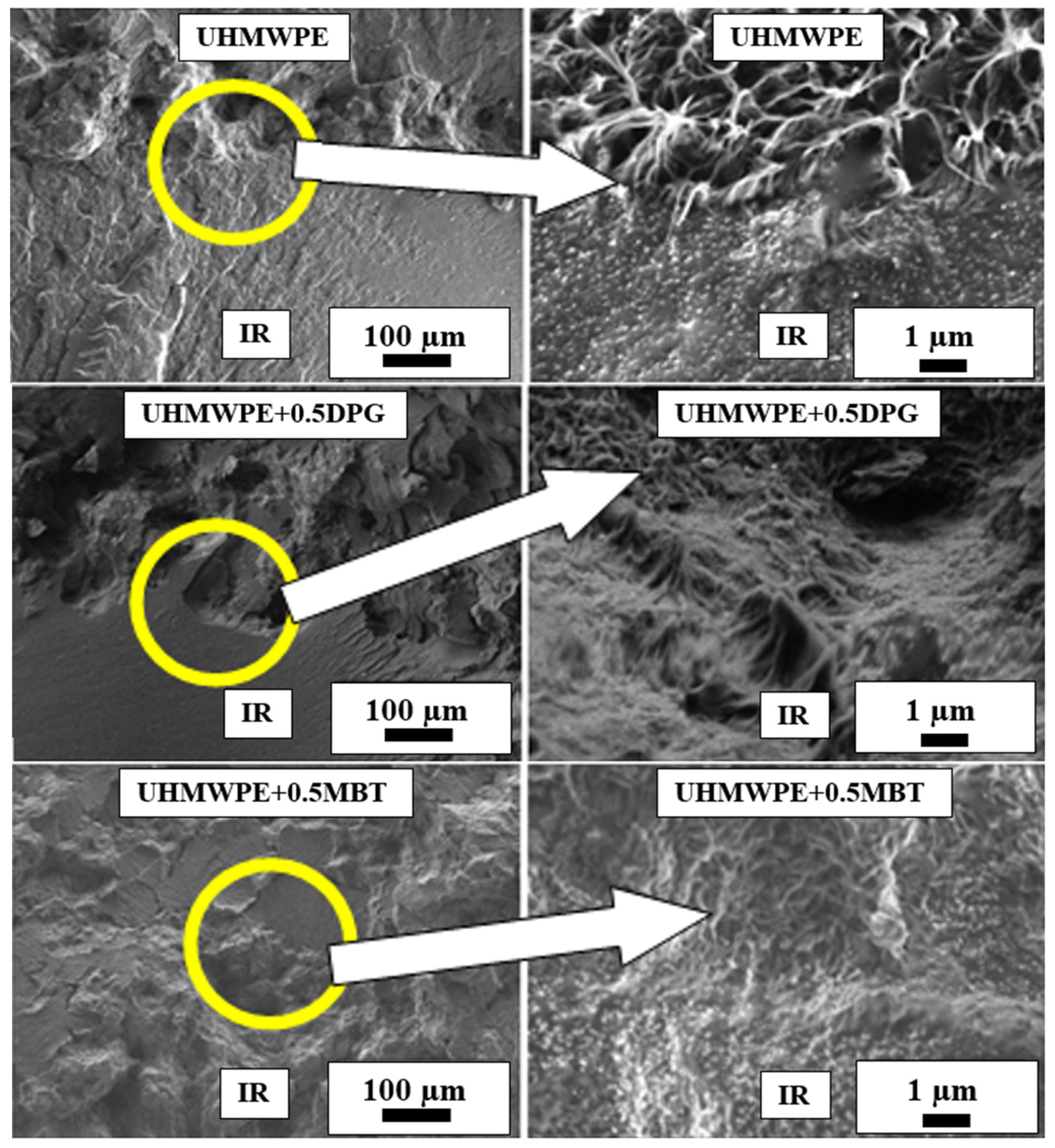

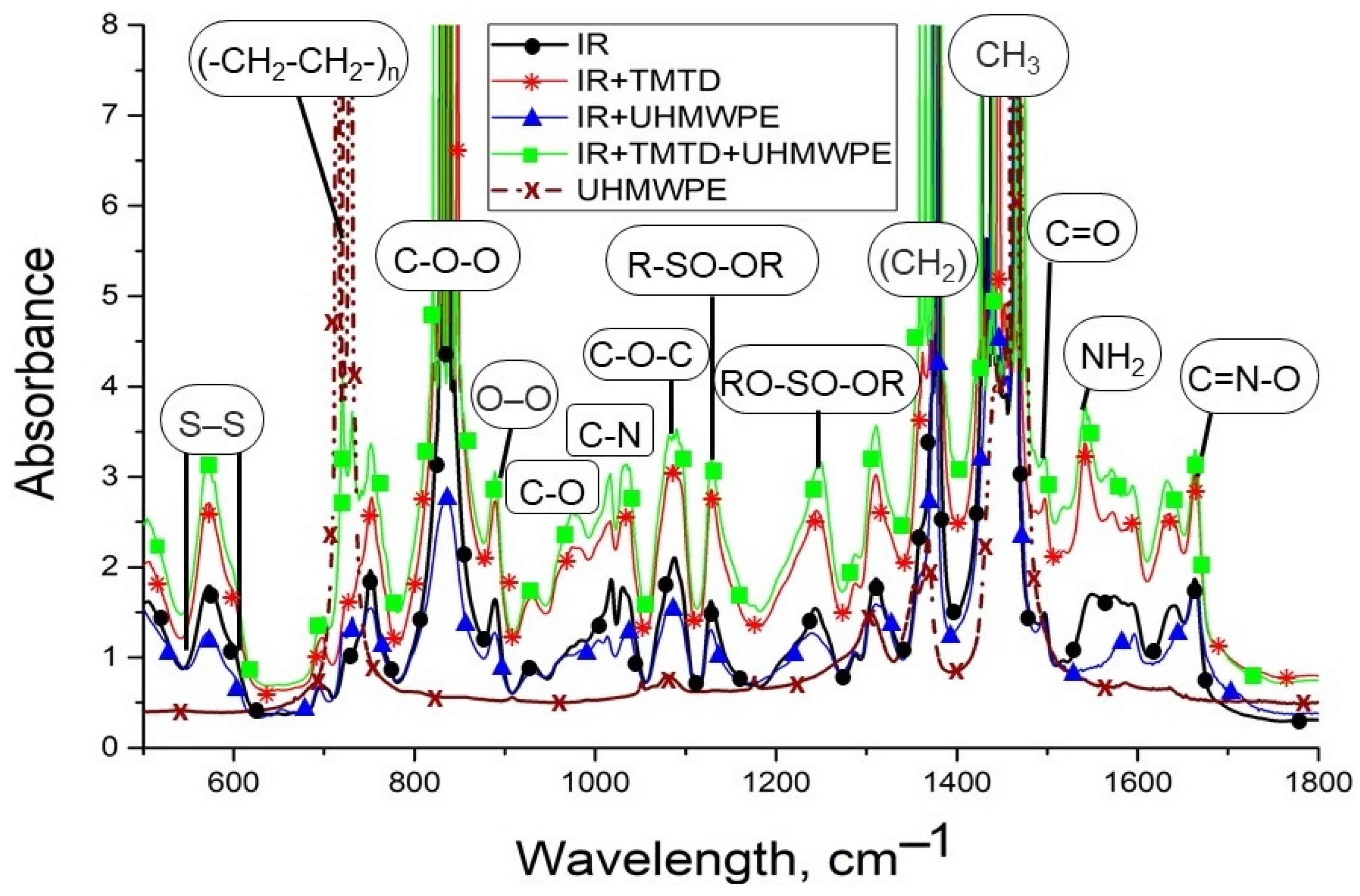
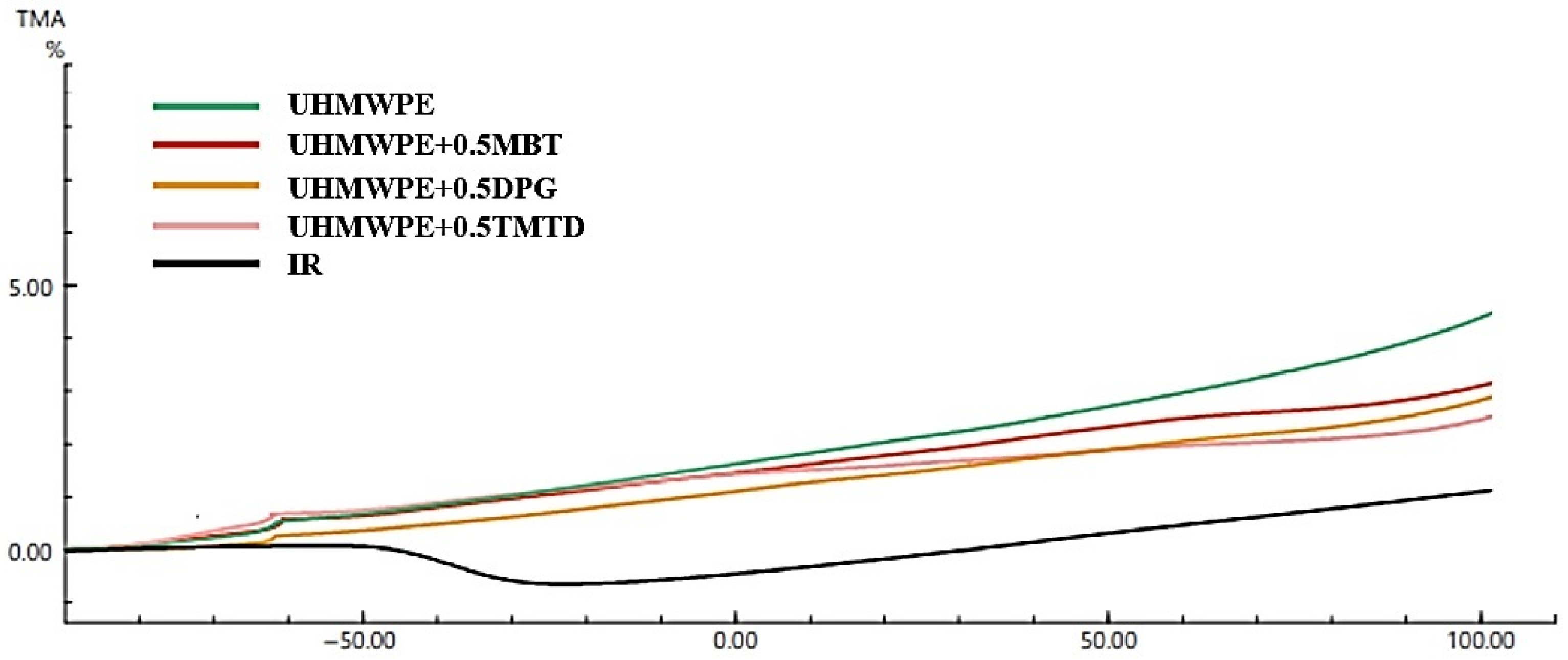
| No. | Compounds | phr | Time of Introduction, min | |
|---|---|---|---|---|
| 1 | 2 | |||
| 1 | IR | 100.0 | 100.0 | 0 |
| 2 | Stearic acid | 2.0 | 2.0 | 0 |
| 3 | 2-mercaptobenzotiazole | 1.5 | 1.5 | 10 |
| 4 | Zinc oxide | 5.0 | 5.0 | 5 |
| 5 | Sulfur | 2.0 | 2.0 | 15 |
| 6 | Diphenylguanidine | 0.3 | 0.3 | 10 |
| 7 | TMTD | - | 0.5 | 10 |
| 8 | Carbon K-354 | 50.0 | 50.0 | 2 |
| Composite Number | Composition, wt.% | |||
|---|---|---|---|---|
| UHMWPE | DPG | MBT | TMTD | |
| 1 | 99.5 | 0.5 | - | - |
| 2 | 99.5 | - | 0.5 | - |
| 3 | 99.5 | - | - | 0.5 |
| Samples | Elongation at Break εp, % | Tensile Strength fp, MPa | Tensile Stress at 100% Elongation f100, MPa |
|---|---|---|---|
| 1 | 879 ± 50 | 22 ± 1 | 1.8 |
| 2 | 539 ± 30 | 17 ± 1 | 2.9 |
Publisher’s Note: MDPI stays neutral with regard to jurisdictional claims in published maps and institutional affiliations. |
© 2022 by the authors. Licensee MDPI, Basel, Switzerland. This article is an open access article distributed under the terms and conditions of the Creative Commons Attribution (CC BY) license (https://creativecommons.org/licenses/by/4.0/).
Share and Cite
Dyakonov, A.A.; Vasilev, A.P.; Danilova, S.N.; Okhlopkova, A.A.; Tarasova, P.N.; Lazareva, N.N.; Ushkanov, A.A.; Tuisov, A.G.; Kychkin, A.K.; Vinokurov, P.V. Two-Layer Rubber-Based Composite Material and UHMWPE with High Wear Resistance. Materials 2022, 15, 4678. https://doi.org/10.3390/ma15134678
Dyakonov AA, Vasilev AP, Danilova SN, Okhlopkova AA, Tarasova PN, Lazareva NN, Ushkanov AA, Tuisov AG, Kychkin AK, Vinokurov PV. Two-Layer Rubber-Based Composite Material and UHMWPE with High Wear Resistance. Materials. 2022; 15(13):4678. https://doi.org/10.3390/ma15134678
Chicago/Turabian StyleDyakonov, Afanasy A., Andrey P. Vasilev, Sakhayana N. Danilova, Aitalina A. Okhlopkova, Praskovia N. Tarasova, Nadezhda N. Lazareva, Alexander A. Ushkanov, Aleksei G. Tuisov, Anatoly K. Kychkin, and Pavel V. Vinokurov. 2022. "Two-Layer Rubber-Based Composite Material and UHMWPE with High Wear Resistance" Materials 15, no. 13: 4678. https://doi.org/10.3390/ma15134678








